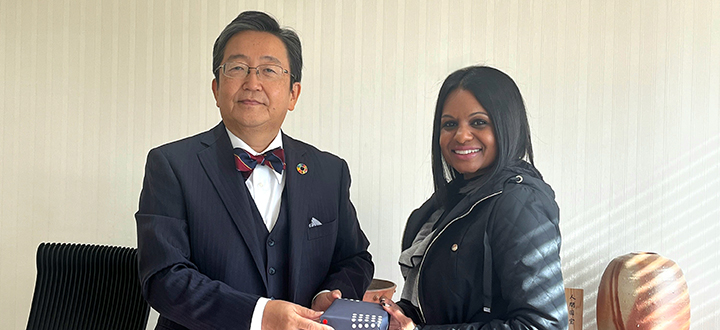College of Science, Engineering & Technology
CSET discusses waste to energy
Prof Diane Hildebrandt delivered a talk on waste to energy as part of the contribution of the College of Science, Engineering and Technology (CSET) to the Research and Innovation month. The talk was based on years of research in the area with her colleagues and postgraduate students. Hildebrandt heads the Material and Process Synthesis (MaPS) research unit, established in 2013.

The MaPS research group, led by Prof. Diane Hildebrandt (right)
The unit focuses on environmentally responsible chemical conversion technologies, with particular emphasis on:
- Utilising surplus and underutilised resources such as municipal waste and sewerage
- Sustainable small scale solutions that are modular and flexible in their applications
Hildebrandt explains biogas as a mixture of methane, carbon dioxide, and hydrogen. It is produced when organic matter is decomposed by bacteria when there is no oxygen present (anaerobic). Examples of anaerobic bacterial processes would be compost heaps and septic tanks.
In her talk, she interrogated waste as sources of energy. According to the study she cited on sewage energy, it is said that in 2012, the world consumed around 5 x 1020 J of energy. Humans produce around 866 billion kilograms per year of faeces. This could produce around 6 x 1018 J/year of energy; thus 1/100 of the world’s energy needs could be produced from human waste.
What about the other waste? A cow produces up to 10 kg / day of wet manure. This could be converted to around 300 l/day of biogas. A gas burner of a stove uses around 50 l/hour of gas when simmering. It could cook for 6 hours a day using the manure from 1 cow.
Consider a rural family who cooks on a two-plate stove for two hours a day at simmer. Heats up 40 l/day water to 50 OC. One cow together with the family’s human waste could supply this energy. Thus we could power households on animal and human waste.
All organic wastes can be used:
- Organic municipal waste
- Manure
- Grass, straw, hay
- Industrial waste such as bagasse (by-product of the cane sugar industry), sawdust
In her determination to put this into practice, Engineers Without Borders (EWB) Unisa, a community engagement project of the College of Science, Engineering and Technology, set up two digesters at two different sites. One site at Muldersdrift is working well. It uses half a bucket of manure every second day. It cooks for four hours a day on this. They no longer use LPG or paraffin for cooking. Lighting was not as successful.
There are 13 digesters being put in the Eastern Cape through a joint project with the South African National Energy Development Institute (SANEDI), the University of Fort Hare and Unisa.
Commercial use of biogas
Hildebrandt presented few cases of biogas in large-scale digesters.
- BMW SA plans on running its Rosslyn production facility on biogas (25-30% of power using renewable). Biogas will be supplied from the 4.4 MW capacity Biogas plant in Bronkhorstspruit.
- Novo Energy has plans to build a dispensing station for demonstration purposes on a landfill site near OR Tambo International airport. They plan on offering motorists free conversion so that their cars can run on biogas. They estimate a fuel savings of between 15% and 25%.
- The City of Johannesburg water utility in 2013 launched a pilot Biogas Project at the Northern Works Waste Water Treatment Plant. In 2012 the cost of treating waste water had escalated to R300 million per annum from R93 million per annum in 2010. This was excluding Eskom’s annual increases. The city’s six treatment plants currently treat 1 billion litres of sewage per day. This has the potential of producing 8.5 MW of electricity (Peter Louw). As a result, Johannesburg Metro Buses will run on biogas.
*By Nkululeko Mpakama
Publish date: 2016/03/22

 From unemployed graduate to business founder
From unemployed graduate to business founder
 Multidisciplinary showcase set to celebrate the creative achievements of Unisa art students
Multidisciplinary showcase set to celebrate the creative achievements of Unisa art students
 Cheers! Unisa toasts its award-winning student brewers
Cheers! Unisa toasts its award-winning student brewers
 Building a community of strategy-as-practice researchers
Building a community of strategy-as-practice researchers
 Matrimonial magnificence as husband and wife graduate at Unisa
Matrimonial magnificence as husband and wife graduate at Unisa